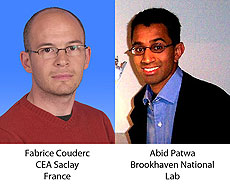A different kind of Higgs boson
 |
| The history of particle physics is replete with silly names and this subject is no different. One of the original names for a model which predicted doubly charged Higgs bosons was the Mini Moose Model. |
Perhaps the most pressing topic in modern particle physics is the exploration of the energy realm called the TeV, or teraelectronvolt. One TeV is equal to a trillion electron volts and is the energy scale of the Tevatron (and the source of the accelerator’s name). This is the energy regime in which the weak force and the electromagnetic force become unified.
Our research over the past quarter century leads us to believe that there is a big discovery just around the corner. Currently, the two most popular ideas are the Higgs boson and supersymmetry. The Higgs boson is a proposal to explain the mass of particles. Supersymmetry suggests that we treat matter particles and force-carrying particles on equal footing. No one has yet demonstrated whether either idea is true.
Physicists can mathematically unify the electromagnetic and weak forces at the TeV energy scale, but the process to break that unification remains unknown. We know that it can be done using the proposed, but unverified, Higgs mechanism, which is thought to appear at the energy level of approximately 1 TeV.
Given the mystery that surrounds the TeV scale, it is inevitable that some theoretical physicists have combined these two ideas, yielding supersymmetric Higgs bosons. In these combined models, there is more than just the one Higgs boson. In the simplest supersymmetric model, there are five Higgs bosons, including some with electrical charge. This is in contrast to the Standard Model Higgs boson, which is electrically neutral.
There are many different ways in which scientists add supersymmetry to our current theories. Each combination has different consequences for Higgs theory. Some of these theories even predict new Higgs bosons with a lot of electrical charge. Many theories make this prediction, including ones that do not involve supersymmetry, so physicists do a generic search for such particles. If such a particle is observed, physicists will deduce which theory was right.
DZero physicists searched for a Higgs boson with twice of the electrical charge of a proton (called H++). This particle would be produced in association with its partner
(H- -). Both particles would decay into muon or tau leptons. This is a challenging analysis, resulting in only a handful of candidates—even using nearly the entire DZero dataset. While DZero physicists did not observe any evidence for these exotic, highly-charged, Higgs bosons, they did rule out a bigger range of possible masses than was previously achieved.
— Don Lincoln
 |
| These physicists from the University of Manchester (UK) performed this very delicate analysis.
|
 |
| These physicists play a central role in DZero tau lepton identification, which was critical to this analysis.
|
|